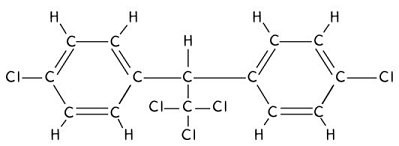 DDT, C14H9Cl5, is a very effective insecticide. It is hazardous to other species, however, because it tends to accumulate in the food chain. Shown above is its chemical structure. Suggest why it remains on plants and in soils for extended periods of time.
DDT, C14H9Cl5, is a very effective insecticide. It is hazardous to other species, however, because it tends to accumulate in the food chain. Shown above is its chemical structure. Suggest why it remains on plants and in soils for extended periods of time.
What will be an ideal response?
DDT is very nonpolar, which can be deduced from its hydrocarbon type structure. DDT, therefore, is not water soluble and does not easily wash away with the rain. This is great for its being an insecticide but terrible for what harm it causes to higher organisms.
You might also like to view...
At $13,700, Namibia has the highest GNI PPP per capita in Southern Africa
Indicate whether the statement is true or false
Global temperatures are
A) rising at a rate of 0.17 C° (0.3 F° ) per decade. B) higher than any time in the last 800,000 years. C) increasing at a decreasing rate. D) increasing by 3% per year.
Match the type of flood with the correct definition
A) Seasonal Floods B) Artificial containment structures fail C) Floods with high precipitation in a short time D) Frozen material creates a temporary dam on a thawing river 1) Ice-Jam Floods 2) Dam-Failure Floods 3) Regional Floods 4) Flash Floods
Judge the following sentence according to the criteria given below: A tidal bulge is created on the side of Earth directly facing the Moon BECAUSE the provided gravitational force is greater than the required centripetal force
A) The assertion and the reason are both correct, and the reason is valid. B) The assertion and the reason are both correct, but the reason is invalid. C) The assertion is correct, but the reason is incorrect. D) The assertion is incorrect, but the reason is correct. E) Both the assertion and the reason are incorrect.